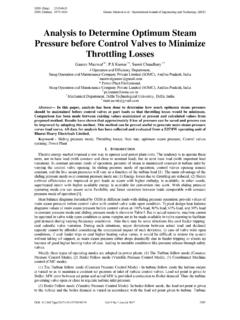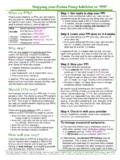Transcription of How to deal with mite infections and to minimize their ...
1 How to deal with mite infestations and minimize their occurrence. David D. Perkins Background Infestation with mites may occur even in well kept laboratories. They proliferate in undessicated cultures Because they are tiny (~130 long), mites can crawl through cotton plugs and can enter covered petri dishes, carrying contaminating conidia from one culture to another. Purity of stocks is suspect by the time mites are detected. Seeing a mite with a belly full of orange conidia walking across an agar or glass surface under the microscopic is an alarming experience, signalling trouble and requiring interruption of other work while cleaning up is given top priority. Reasonable precautions can reduce the probability of infestation.
2 At Stanford, we have reduced the frquency to less than once a decade. Effective measures have been devised for dealing with the problem when it does occur, but recovery from an infestation is laborious and requires prompt and vigorous action. Procedure Killing mites: Cultures and crosses that can be readily replaced should be autoclaved, together with exposed racks and containers. Cultures to be recovered can be freed of mites in either of two ways. Freezing at 18 C or 20 C for 24 hours kills both adults and eggs (Subden and Threlkeld 1966, Allison and Hilton 1994). (Refrigeration at 5 C slows mites but does not kill them.) Conidiashow high survival after freezing, but ascospores do not.
3 Thus freezing is not an option for crosses. Exposure to carbon dioxide provides an alternative, killing mites without impairing ascospore viability (Metzenberg 1985): "Cultures at risk [were packed] into desiccators with lumps of dry ice in the bottom (about 100-200 g. dry ice per liter of capacity). The valve at the top was left open for the escape of air and CO2, and the plates and tubes were left in an atmosphere of CO2 for 2 days at room termperature. The lid was then removed, the cultures were allowed to sit in air so that any possibly resistant eggs could hatch, and the treatment was repeated. No mites could subsequenntly be found in any cultures. Ascospores shot before the treatment germinated normally, and immature crosses proceeded to maturity.
4 Vegetative cultures remained viable. Mites are probably killed by acidification of their body fluids, while Neurospora is not harmed." Rescued cultures must be used with caution because of the possibility that they have been contaminaed with Neurospora brought by mites from other cultures. Purification may be necessary. Disinfection and cleaning up: Exposed racks, containers, etc. should be autoclaved or hot-air sterilized. Contaminated incubators, refrigerators, shelves, and desktops should be disinfected. The Tatum lab and the Perkins lab at Stanford found the insecticide Lindane ('Gammexane'. 1, 2, 3, 4, 5, 6 hexachlorocyclohexane) to be highly effective as a miticide when a solution is painted on surfaces.
5 Lindane is available from pet stores as a liquid solution. (If it is available as a powder, a saturated solution in 95% alcohol is used.) Subden and Threlkeld (1966) advocate using the mitocide Kelthane (Dicofol). Threlkeld (personal communication to Perkins) has suggested using the insecticide Malathion as an alternative, or alternating between Kelthane and Malathion, both of which are less toxic to mammals than Lindane. Other mitocides have been used by Drosophila workers, who have a long history of struggling with mite infestations (Ashburner 1989, Allison and Hilton 1994, Roberts 1998). Among these are Tetradifon (Tedion), 1 Benzylbenzoate, and Methylcarbamate. Whatever is used, exposure to skin should be avoided.
6 For toxicity and possible carcinogenicity of mitocides and insectosides, see the Merck Index. Precautionary measures for avoiding infestation: The source of laboratory infestations is unclear. Cleanliness is important above all. Storage and work areas should be kept free of dust. As a precautionary measure, it seems wise to keep fruits, vegetables, and potted plants out of working areas or refrigerators where cultures are stored. Where problems with mites are chronic, precautionary use of mitocides may be advisable. Miticidal shelf paper treated with methylcarbamate is effective in preventing migration of mites (Allison and Hilton 1994. Available from ). Plates and slants containing agar should not be left at room temperature for long periods.
7 Cultures to be retained should be refrigerated, frozen, or preserved on silica gel or by lyophylization. Cultures for discard should be autoclaved promptly. Mites thrive in a humid environment and can proliferate in tubes or plates until the medium dries down. Infestations commonly center around unrefrigerated large slants, which may stay moist for several weeks before they become dessicated. Lindegren et al. (1939) prevented mites from entering cultures by pulling the cotton plug two-thirds out of the tube, dipping it in glycerin, squeezing out the excess, and reinserting. This ponderous procedure would now seem to be a measure of last resort. Conidiating strains brought into the laboratory from nature should be quarantined until they have been kept at 20 C for at least 24 hours.
8 Likewise, it would be prudent to freeze stocks received from other laboratories if there is any suspicion that they might be infected. Identity of mite species. Determining mite species might help in identifying the source. Ashburner (1989) suggests that specimens be preserved in ~70% alcohol + 5% glycerol and sent to a mite specialist for identification. References Allison, G., and H. Hilton 1994. A combination of techniques for the control of Drosophila mites. Drosophila Information Service 75:422-43. Ashburner, M. 1989. Drosophila: A Laboratory Handbook. Cold Spring Harbor Laboratory Press. Lindegren, C. C., V. Beanfield, and R. Barber 1939. Increasing the fertility of Neurospora by selective inbreeding.
9 Bot. Gazette 100:592-599. The Merck Index, 13th Edition. 2001. Merck & Co., Inc. Whitehouse Station, N. J. Metzenberg, R. L. 1985. Killing mites without killing Neurospora. Neurospora Newsl. 32: 22. Roberts, D. B. (ed.) 1998 Drosophila: A Practical Approach. 2nd ed. Oxford University Press. Subden, R. E., and S. F. H. Threlkeld. 1966. Mite control for Neurospora labs. Neurospora Newslett. 10: 14. 2







